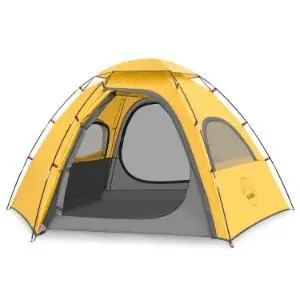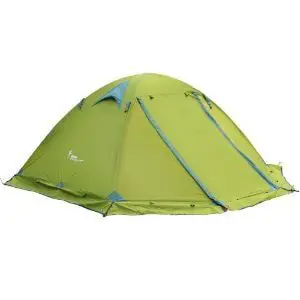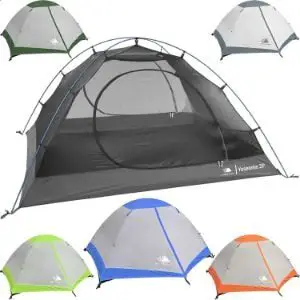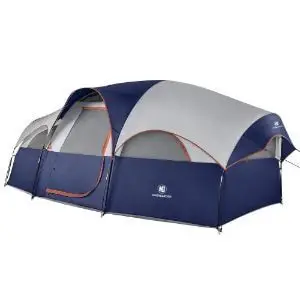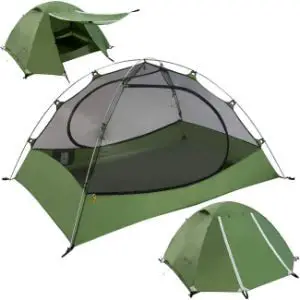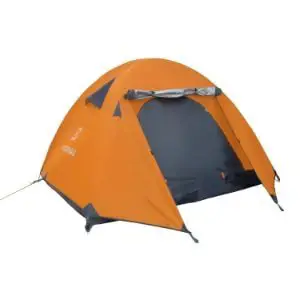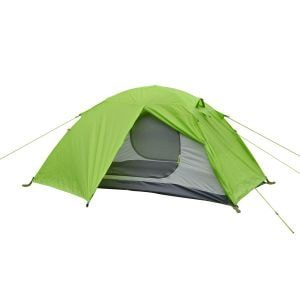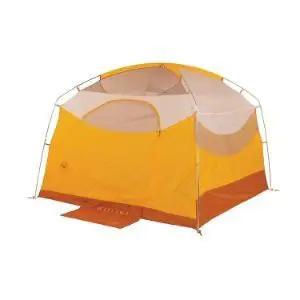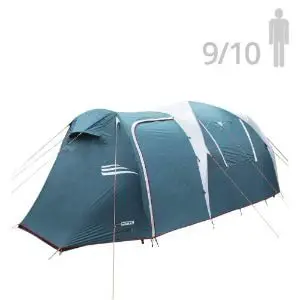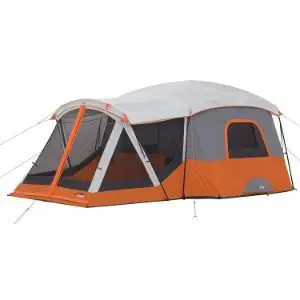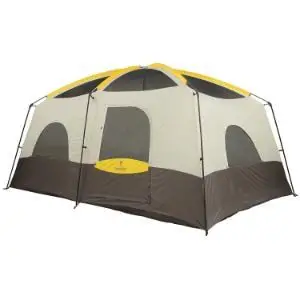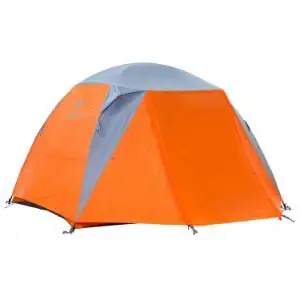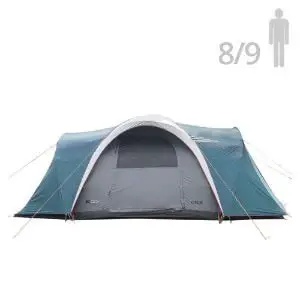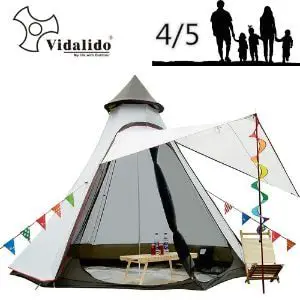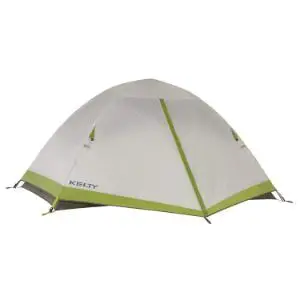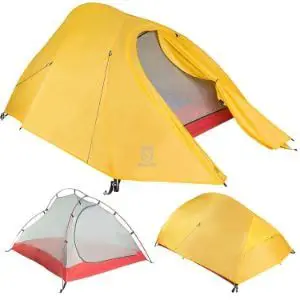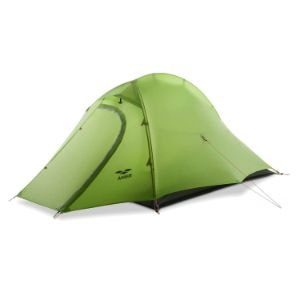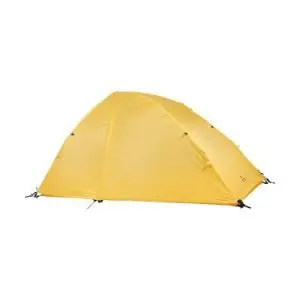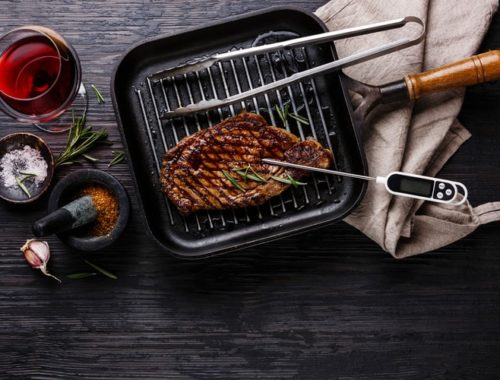A recent North American Camping Report revealed that North Americans are now spending more time camping than ever before. While that’s good news for the health and happiness of all those getting in on the action, it also means there are now more tent manufacturers on the go that ever before, too. So how do we know the good ones from the bad ones? And how do we know which tent will be the ideal choice for our camping style, group size, and the conditions in which we tend to do most of our camping? In this article, we aim to answer those questions with an in-depth buyer’s guide that offers our pick of the top 25 tents out there in 2020 for all kinds of camper.
We reviewed dozens of tents for camping to identify the best of the best. We examined a range of factors, including capacity, weather resistance, convenience, weight, design, cost, and average customer reviews.
Having considered a large number of tents for camping, we chose the Kazoo 4-Person Tent as our top pick. This tent ticks all the boxes, using extremely rugged, waterproof, 210T rip-stop polyester rainfly, a breathable polyester tent body, two large doors and mesh windows for ventilation and bug prevention, a duo of spacious vestibules, plenty of interior storage pockets, and offering a total of 56 square feet of interior floor space. All in all, this tent’s a great choice for families of four for camping at either an established campsite or deep in the backcounty.
In This Article
The 5 Top-Rated Tents for Camping
| Editor's Picks | Brand | Rating |
|---|---|---|
| Best Tent for Camping Overall | Kazoo 4-Person Tent | 5.0 |
| Best 8-Person Tent for Camping | Coleman Montana 8-Person Tent | 4.3 |
| Best Budget Buy | Coleman Sundome Tent | 4.5 |
| Best Family Tent for Camping | CORE 9 Person Instant Cabin Tent | 4.6 |
| Best 2-Person Tent for Camping | ALPS Mountaineering Zephyr 2-Person Tent | 4.6 |
*Ratings are from Amazon at the time of publication and can change
Best Tent for Camping Overall: Kazoo 4-Person Tent
Having considered a simply vast array of options, the camping tent that wins our vote as the best model currently on the market is the Kazoo 4-Person Tent. This tent trumps its closest competitors for a number of reasons, but most importantly owing to its outstanding performance in each of the desirable design characteristics and features listed below and exceptional price-to-performance ratio.
With 56 square feet of interior floor space, this tent is one of the roomiest 4-person models you’re likely to come across and is ideal for either four adult sleepers or two adults and three smaller kids. In addition to all that internal space, the Kazoo also boasts two sheltered vestibules that provide ample extra space for gear storage, plenty of large interior pockets, and an impressive peak height of 57 inches.
The tent’s simple, three-pole design means it provides plenty of stability in windier conditions and can be set up in just a few minutes. And when the skies open, the Kazoo has you well and truly covered, too. Not only does it boast a tough, ripstop rainfly with a hydro-static head rating of 3,000 mm, it also uses fully taped seams and storm flaps to prevent any unwanted H20 seeping in at these common points of weakness in most tents’ wet-weather defences.
Other nice touches in this tent include doors that convert into “sunshade” porch areas, a robust carry bag, large mesh windows to improve ventilation while keeping out bugs, robust zippers, a footprint for the vestibule area, and eight guylines for added stability in high winds.
The bottom line? Excellent value for money and a great choice for year-round camping with all the family, whether you’re car camping, visiting a national park, or heading deep into the backcountry.
Kazoo 4-Person Tent Key Features:
- 56 square feet of floor space
- 57-inch peak height
- 2 large vestibules
- Waterproof (3,000 mm hydrostatic head rating)
- Breathable fabric
- Can be pitched in 2-3 minutes
Best 8-Person Tent for Camping: Coleman Montana 8-Person Tent
If spaciousness ranks high on your list of priorities or you plan on doing your camping with all the family and maybe even a friend or two in tow, then you’ll be hard-pressed to find a better option for you camping trips than the Coleman Montana 8-Person Tent.
This tent is simply palatial in its proportions, offering a whopping 112 square feet of floor space, a peak height of six feet and two inches, and a large, extended door awning that provides plenty of sheltered space for external gear storage. In short, if a home away from home’s what you’re looking for, then this may very well be just the tent for you.
The Montana, however, has a lot more to offer than oodles of space alone. While not intended for use in extreme weather, its WeatherTec waterproofing system, patented corner welds, and inverted seams all make it more than capable of dealing with the odd rain shower and preventing groundwater from soaking through the floor of the tent. It also uses huge mesh panels in the tent body to improve ventilation and let you keep an eye on the kids while kicking back inside, a four-pole design for stability in windy conditions, and an over-sized, hinged door, interior storage pockets, and an expandable carry bag for added convenience.
The tent’s continuous pole sleeves and the patented pin-and-ring system also makes it relatively easy to set up, even for newcomers to the game of camping. While setup might take a little longer than with other tents in our review, this is only to be expected with a tent with the Montana’s proportions and is a small price to pay for what this tent offers once pitched.
Coleman Montana 8-Person Tent Key Features:
- 112 square feet of floor space
- 6’2″ peak height
- Patented corner welds for increased durability
- Extended door awning
- Hinged, D-shaped door for easy entry and exit
- Large mesh panels for improved ventilation
Best Budget Tent for Camping: Coleman Sundome Tent
The Coleman Sundome Tent is an excellent choice of tent for fair-weather campers who want a shelter that’s low on cost but high on quality and is built to last a lifetime.
This tent uses a simple but very sturdy two-pole, freestanding, and two-layer design that offers excellent stability in high winds and enough waterproofing to keep your dry in light to moderate precipitation. The interior of this tent is also roomy enough for a group of four adults or even two adults and three younger kids, with its 61 square feet of floor space and four-foot-six-inch peak height representing an upgrade on the capacity and dimensions of most four-person models of tent in its price range.
The Sun Dome also offers excellent ventilation thanks to a large hooded window on the rear and mesh vents in the roof, making it a great option for camping in warmer temps or high humidity. A 1000D polyethylene floor with welded seams reduces the risk of springing any leaks on the underside of the tent, while the polyester body and fly fabric offer more than enough ruggedness and tear-resistance for even the wildest of backcountry adventures.
In terms of convenience, the Sun Dome is a bit of a winner, too, taking less than ten minutes to set up and featuring a zippered electrical access port to run AC power into the tent, a ground vent, interior storage pockets, a hanging loop in the ceiling for lamps or lanterns, and very easy-to-use pole sleeves and clips.
Coleman Sundome Tent Key Features:
- 61 square feet of floor space
- 4’11” peak height
- Tough, 1000D polyethylene floor
- 10-minute setup time
- Welded seams enhance waterproofing
Best Family Tent for Camping: CORE 9-Person Instant Cabin Tent
Few tents are quite so capable of providing the feel of a true home-away-from home as the CORE 9-Person Instant Cabin Tent.
This wonderfully roomy, easy-to-assemble, and practical tent wins our vote for a number of reasons. First up, it boasts an incredible 126 feet of floor space and a 78-inch peak height, making it one of the most spacious and livable tents out there, even among its 9-person competitors. Most tents of this size, moreover, are notoriously tricky to pitch, requiring many hands and more than half an hour of time that might otherwise be spent kicking back, enjoying the contents of your cooler, and enjoying the views. Not so with the CORE Instant Cabin Tent… This tent’s frame consists of robust telescoping poles that come pre-attached to the structure, meaning it can be assembled in under a minute with a little bit of practice (2 minutes for slackers!).
But there’s more to this tent than just a snappy setup time and enough space to accommodate a small army…
The CORE isn’t made for use in extreme weather conditions, but its 600 mm hydro-static head inner and 1,500 mm HH rainfly make it more than well enough equipped to deal with the odd rain shower. It also uses heat-sealed seams to prevent any leaks springing in this common point of weakness and breathes as well as any other tent we know thanks to its huge mesh windows and doors.
Finally, this tent also comes with one feature sure to appeal to families or groups who like to have a little bit of private personal space, namely a detachable divider than can be used to make the tent’s interior into two separate rooms.
CORE 9-Person Instant Cabin Tent Key Features:
- 126 square feet of floor space
- Lofty 76-inch peak height
- Excellent ventilation from mesh windows and doors
- Telescoping poles
- Large storage pockets in tent walls
- Short setup time
Best 2-Person Tent for Camping: ALPS Mountaineering Zephyr 2-Person Tent
For those who plan on putting in some serious mileage on the trails before setting up camp and are looking for a healthy balance between comfort, weight, and weather resistance, they don’t come much better than the ALPS Mountaineering Zephyr 2-Person Tent.
This tent uses a freestanding, two-pole design that cuts down assembly time to no more than a few minutes and provides excellent performance in strong winds. It’s also made with the most rugged and waterproof materials of all the tents in our review, using heat-sealed seams in combination with a 75D, 185T polyester rainfly with a 1500 mm hydro-static head and a 75D, 185T poly taffeta floor with an impressive 3000 mm hydro-static head rating. In terms of weather resistance, you can’t ask for much more from a three-season tent.
The Zephyr, being a two-person tent, naturally doesn’t boast the same roomy proportions as the other tents in our review. However, its 28 square feet of floor space makes it spacious enough for two adult sleepers. Its 38-inch peak height, moreover, means it’s low enough to provide superior stability in strong winds to models that pip the 50-inch mark.
For such a small tent, the Zephyr also scores remarkably high on livability, mainly thanks to its use of two doors, two sizable vestibules, and a gear loft and large mesh storage pockets that free up floor space by letting you stow your clothing and kit in the tent walls or roof.
Finally, this tent’s double-walled design and full-mesh interior mean its almost peerless as regards ventilation and, as such, the ideal pick for campers who plan on doing their camping in warmer climes.
ALPS Mountaineering Zephyr 2-Person Tent Key Features:
- 28-square feet of floor space
- 38-inch peak height
- Waterproof
- Weighs 5 lbs. 8 oz.
- 2 doors and vestibules
- Freestanding design
Who Should Buy a Tent for Camping
Camping is a very cheap, fun, and healthy way to spend vacations or weekends either with friends and family or entirely on your lonesome.
In terms of affordability, few other free-time activities can come close to matching camping. Even if you only happened to sleep in even one of the priciest tents on the market for a mere 50 nights, the typical per-person, per-night cost of the tent would work out at little more than $1 per might if camping in the backcountry. Not bad at all, right?
More importantly, camping is a great way to spend quality time with your family and enjoy some much-needed downtime away from the hassles of work, computers, cellphones, and other potential “stressors.” Recent studies have also highlighted the beneficial impact of time spent in nature on both mental and physical health, meaning there’s now more reason than ever before to hit the trails and get your camp on!
Important Features to Consider
A tent for camping should do several things well. Here’s what to consider when choosing a tent for your camping adventures:
- Capacity. The capacity of your tent refers to the number of sleepers it can accommodate. Unfortunately, capacity ratings are not subject to industry standardization, so tent makers are apt to overstate the capacity of their tents in a bid to appeal to more buyers, frequently labeling tents “four-person,” “eight-person,” and so on when, in reality, the tents are far short of the floor space required to comfortably accommodate that number of adult sleepers. So, how are we to know how many people a tent will really sleep? When choosing your tent, use the manufacturer’s person rating only to give you a ballpark, rough guide of the tent’s capacity and instead hunt down the tent’s dimensions in the product specifications or additional photographs (which usually contain a blueprint). By multiplying the tent’s length by its width, you can easily calculate its overall square footage, i.e. 7 feet times 10 feet equals a total of 70 square feet. Given that every adult sleeper will require roughly 15 square feet of floor space, you can then decide if the tent will be suitable for you and your family or camping crew.
- Livability. The inclusion of a few features in particular can go a long way to enhancing a tent’s livability. We’ve listed the most important of these below:
- Generous peak height (that is, the height of the tent at its tallest point): ideally, this should be over 40 inches in smaller (1 to 3-person backpacking tents) and over 55 inches in family or “basecamp” tents
- A large vestibule in which you can store wet and dirty gear
- Large storage pockets: these allow you to keep clothes and gear off the floor, thereby leaving more floor space for the tent’s occupants
- A “gearloft”: a large, usually detachable mesh shelf in the roof of the tent that provides additional storage space
- Mesh panels: these provide views outside the tent and also improve ventilation
- Hanging loops for lanterns, headlamps, and/or clothing
- Waterproofing. The level of waterproofing offered by different models of tent varies greatly. While some models boast such impressive water-resistance that you feel they might double up nicely as a submarine, others are designed for fair-weather use only and will offer little resistance to even to the lightest of rain showers. So, how do we know which tents fall into the former category and which fall into the latter? Waterproofing in tents is quantified and standardized by what are known as hydro-static head (HH) ratings. This rating is tested by applying water pressure to the surface of outdoor fabrics and measuring at which point they let water seep through. As an example: if the fabric begins to leak with 1,500 mm of water pressure, then its HH rating will be 1,500 mm. To give you an idea of how HH ratings can translate into something more meaningful for you, the camper, let’s look at the degree of water-resistance you can expect materials with various HH ratings to provide:
-
- 1,000 mm = A 1K HH rating is the bare minimum required for manufacturers to market their products as “waterproof.” In practice, sadly, tent fabrics with this HH rating will only be capable of withstanding very light and/or short-lived showers.
- 1,500 mm-2,000 mm = This rating is commonly found in the rainfly of three-season tents. Tent fabrics in this range are capable of withstanding prolonged exposure to heavier rainfall.
- 3,000 mm = Commonly found in the rainfly on expedition and alpine tents, and groundsheets or footprints in standard tents, fabrics with this rating offer reliable waterproofing in more extreme conditions and heavy downpours.
- Ventilation. Tents with inadequate ventilation are usually wet tents. The humidity produced by the tent’s sleepers in the form of sweat and respiration accumulates on the tent walls in the form of condensation if it has no means of escape, which typically results in a very damp tent interior come morning.
To avoid any ventilation or airflow problems, when buying your tent, look for the following features:- A double-walled design: this permits airflow between the tent body and the rainfly
- Large mesh ventilation panels or windows
- Ventilation panels or flaps in the flysheet
- Awnings or large “storm flaps” that extend over the doors to let you open them without exposing the tent interior to precipitation
- A doubled-doored design that encourages airflow throughout the tent
- Ease of Setup. The time it takes to pitch different models and types of tent can vary greatly, with many pop-up tents assembling in a matter of seconds and some larger family tents taking nearly an hour, depending on how many co-campers are there to lend a hand. Choosing a tent that’s easy to pitch not only buys you more time to relax and enjoy yourself but can also save you a world of frustration and a good soaking should you happen to arrive at your campsite in the middle of a rain shower. When buying your tent, the most important features contributing to short setup time include the following:
- Color-coded poles, grommets, clips, and pole loops
- A freestanding design
Attachment clips that connect the tent’s outer sheet (the rainfly) to the tent body to permit simultaneous pitching
- Weight. The type of camping you plan on doing will largely determine your parameters with regard to the weight of your tent. If, for example, you envision using your tent for car camping, then you can afford to choose a heavier tent knowing that won’t have to carry it great distances before pitching. If, on the other hand, you plan on putting in some mileage on the trails before bunking down for the night, then “lightweight” or “ultralight” is the way to go. Sadly, the above terms are thrown about quite casually by tent manufacturers in a bid to boost sales. As such, you should always take the time to find any tent’s actual weight before clicking “buy” and compare this with other models you might be considering. For a general guide to the weight range of lightweight tents for varying capacities, take a peek at the following:
-
- 1-person tent: 2-3.5 lbs.
- 2-person tent: 3.5-6 lbs.
- 3-person tent: 5-8 lbs.
- 4-person tent: 8-13 lbs.
- 6-person tent: 14-17 lbs.
Frequently Asked Questions
How much is a camping tent?
The cost of camping tents varies greatly depending on the tent’s size and the quality of the materials used. As a general rule, the cheapest tents out there are one or two-person tents that use very thin (and usually not very abrasion-resistant) fabrics and cheaper poles mode with plastic or fiber glass. While you can get your hands on one of these tents for well under $50, they are typically made for fair-weather camping in your yard or at festivals and won’t be of much use in windy or wet conditions.
Three-season and four-season backpacking tents are usually the most expensive of the lot. These tents use ultralight materials that offer excellent waterproofing, tear-resistance, breathability, and stability in high winds whilst weighing in at considerably less than those used on cheaper, car-camping models.
Some defining characteristics of such tents are minimum hydro-static head ratings of 1,500 mm in the fly and 3,000 in the groundsheet, tiny trail weights (under 4.5 lbs for two-person models), carbon fiber or aluminum poles, and, in most cases, a double-walled design. Tents offering all of the above are designed for use in more extreme conditions in the backcountry and can cost anything from $150 to $500 for a one, two, or three-person tent. Models with a capacity of four persons and over, however, could set you back anything from $250 to $900.
There are, thankfully, a plethora of tents that fall into a broad category between the two above extremes. These are typically 2/3-season tents that offer decent waterproofing (over 1,200 mm HH in both the rainfly and groundsheet), use quality aluminum poles, and which don’t quite fall into the “featherweight” category occupied by the priciest tents on the market but are light enough to make them easily portable on backcountry backpacking trips. Tents that tick the above boxes can be found for under $100 for one or two-person models and under $200 for three, four, and five-person models. For models with a 6 to 12-person capacity, prices usually rise relative to the number of sleepers the tent can accommodate, but there are plenty of 12-person tents on the market that offer reasonable waterproofing, durable materials, and convenience-enhancing features for under $300.
What do you need for tent camping?
The required kit for any camping adventure is summarized nicely in the “Ten Essentials of Camping and Backpacking.” First introduced as the Ten Essentials of Mountaineering by a group called The Mountaineers in the Pacific Northwest in the 1930s, this modernized take, as the name suggests, itemizes every piece of kit required for safe and comfortable outings in the backcountry. Below, we’ve added each entry on the list along with examples.
- Navigation (compass, map, and/or GPS device)
- Sun protection (sunscreen, sunhat)
- Insulation (sleeping bag, sleeping mat)
- Illumination (headlamp, lantern)
- First-aid supplies
- Fire (matches, lighter, firestarters)
- Repair Kit and Tools (repair patches for your tent, sleeping bag, and sleeping mat, plus a multi-tool or similar)
- Nutrition (grub!)
- Hydration (water)
- Shelter (tent)
While you’re camping, you may still feel a desperate need for coffee, and if that’s the case, why not take one of The Best Pour Over Coffee Makers?
How do you stay warm in a tent?
The most important pieces of kit you need to stay warm in a tent are a sleeping bag and a sleeping mat. Sleeping bags come with temperature ratings that state the lowest temperature at which the user will remain comfortable when sleeping in the bag. As a general rule, when choosing your sleeping bag you should bear in mind the coolest nighttime temps you expect to encounter on your camping trips and then opt for a bag with a rating at least 10 degrees Fahrenheit below in order to provide a “buffer”.
Sleeping mats are usually inflatable mattresses used beneath your sleeping bag. Not only do these make life inside your tent more comfortable by raising you above the uneven, bumpy terrain beneath the tent but also place a layer of insulation between you and the ground, which can be several degrees cooler than air temperatures inside the tent.
Should you put a tarp over your tent?
The only circumstances in which you might need to put a tarp over your tent are if your tent isn’t waterproof, has a low waterproof rating, if you anticipate particularly heavy precipitation, or if you have a tear in the fabric that is too large to mend with repair patches included with your tent. If your tent has a hydro-static head rating of 1,500 mm or above, however, a tarp will only prove useful in extremely heavy and sustained downpours.
That said, tarps are a very handy addition to your camping kit and can be used in a variety of ways, most notably as a groundsheet to prevent groundwater leaking into your tent, flooring for your porch area, a sun-block when laid against the wall of your tent in high temperatures, or a windblock when suspended between trees or hiking poles.
Other Tents for Camping We Reviewed
We looked at 20 other tents for camping. Even though they didn’t make our 5 best tents for camping list, they’re the best of the rest and each is still a great option for your outdoor adventures. The information you’ll need to compare each one is included with the listing.
Budget Tents for Camping
This dome-style tent uses a geodesic design for added stability in strong winds and robust PU-coated fabric with a hydro-static head rating of 3,000 mm, making if one one the best budget options for wet-weather camping out there.
Key Features:
- 39 square feet of floor space
- Waterproof (3,000 mm HH rating)
- 53-inch peak height
- Weighs 7.5 lbs
Cost: $89.99
A superbly robust, well-made little tent that is a fraction more spacious than most two-person models and offers far superior weatherproofing to most other backpacking tents in its price range.
Key Features:
- 35 square feet of floor space
- 45-inch peak height
- Waterproof (3,500 mm HH rainfly; 4,000 mm HH flooring)
Cost: $79.99
Hyke & Byke Yosemite 2-Person Backpacking Tent with Footprint
A very lightweight dome-style tent that offers outstanding weather protection and plenty of features that boost livability, including a double-walled design for improved ventilation, a huge gearloft for storage, and two doors with large vestibule areas.
Key Features:
- Weighs only 4.8 lbs with footprint
- Waterproof (5,000 mm HH footprint; 2,000 mm HH rainfly)
- 34 square feet of floor space
Cost: $89.97
This one offers more tent and quality per dollar than just about any other high-capacity model on the market, with a total of 160 square feet of floor space, 7-foot peak height, and a hydrostatic head waterproof rating of 4,000 mm.
Key Features:
- 160 square feet of floor space
- 7-foot peak height
- Waterproof (4,000 mm HH)
Cost: $159.99
Clostnature 3-Person Backpacking Tent
With just 43 square feet of floor space, this isn’t the roomiest three-person tent out there but makes up for this slight shortcoming with a tiny pack weight and outstanding waterproofing.
Key Features:
- 43 square feet of floor space
- 4,000 mm HH rating
- Weighs only 6 lbs.
Cost: $85.99
This very sturdy tent uses highly waterproof, hard-wearing materials and has enough floor space for two adults and a kid. It’s also very easy to pitch, performs well in windy conditions, and weighs in at a very friendly 4.4 lbs.
Key Features:
- 40 square feet of floor space
- 46″ peak height
- Waterproof
- Weighs only 4.4 lbs.
Cost: $85.99
ALLBEYOND Ultralight 3-Season 1-Person Backpacking Tent
For solo campers, they don’t come much better than this fantastically lightweight, waterproof, and surprisingly roomy tent. With tough 150D anti-tear fabric, a rainfly with a 3,000mm hydrostatic head rating, and weighing in at just 3.5 pounds, this tent is ideal for those headed deep into the backcountry to do their camping.
Key Features:
- 21 square feet of floor space
- 39-inch peak height
- Waterproof (3,000 mm HH rating)
- Weighs just 3.5 lbs.
Family Tents for Camping
With 75 square feet of floor space, a 76-inch peak height, 12 interior gear pockets to free up floor space, gear loops galore, and even a small welcome mat in the porch, this is one of the most convenient and livable 6-person tents out there.
Key Features:
- 75 square feet of floor space
- 76-inch peak height
- Waterproof (1,500 mm HH in flooring and rainfly)
Cost: $279.95
This beast of a tent offers oodles of space for as many as 10 sleepers and boasts far superior waterproofing to most other high-capacity tents. It might be pricey, but for those who like to do their camping in all weathers, it’s worth every penny!
Key Features:
- 140 square feet of floor space
- 6’2″ peak height
- Waterproof (2,500 mm HH rating)
Cost: $399.95
CORE 11 Person Family Cabin Tent
Another monstrously proportioned tent that has enough room for all the family, a few friends, and even your pets. It also scores high on breathability and offers a very home-like feel owing to a two-room design and large mesh windows that let you kick back and enjoy the views from inside.
Key Features:
- 204 square feet of floor space
- 86-inch peak height
- Two-room layout
Cost: $229.99
Browning Camping Big Horn Tent
An incredibly sturdy, spacious, and well-made tent that can accommodate up to ten sleepers and offers just about the best waterproofing and wind resistance of all the high-capacity tents in our review.
Key Features:
- 150 square feet of floor space
- 87-inch peak height
- Two-room wall divider
- Waterproof (2000 mm HH)
Cost: $235
Marmot Limestone 6-Person Camping Tent
As with all things Marmot, this tent is truly built to last. It’s also highly waterproof, breathable, and light enough for families or groups who plan on heading deep into the backcountry before setting up camp.
Key Features:
- 83.8 square feet of floor space
- Weighs 17 lbs. 9 oz.
- Waterproof (1,500 mm HH)
- 76-inch peak height
Cost: $341
This smaller version of the NKT Arizona tent featured above offers the same solid waterproofing, robust build, and convenient features and uses a tunnel-style design for added stability in high winds.
Key Features:
- 150 square feet of floor space
- 6’2″ peak height
- Waterproof (2,500 mm HH)
Cost: $324.95
Vidalido Dome Teepee Camping Tent
This wildcard entry on our list weighs only 10 pounds and boasts the kind of waterproofing you’d expect to find on far pricier alpine or expedition tents. It also scores very high on livability thanks to a roomy interior, lofty peak height, and an extendable awning.
Key Features:
- 70 square feet of floor space
- 7.9-foot speak height
- Waterproof (3,000 mm HH rating)
2-Person Tents for Camping
MOON LENCE 2-Person Backpacking Tent
This superbly well-made tent is roomy enough for two adult sleepers, waterproof enough for three-season adventuring, and light enough for those who plan on putting in a lot of mileage on the trails before setting up camp. All told, great value for money and a good pick for backcountry adventurers.
Key Features:
- 33 square feet of floor space
- 47-inch peak height
- Waterproof (2,000 mm HH rating)
Cost: $79.99
Kelty Salida Camping and Backpacking Tent
A rugged, hard-wearing little tent that complements the livability offered in its 31 square feet of internal floor space with a roomy vestibule and decent peak height. It’s also reasonably lightweight, highly waterproof, and far more breathable than most other tents in its price and performance range.
Key Features:
- 31 square feet of floor space
- 10 square feet of vestibule storage space
- Waterproof
- Lightweight (4.5 lbs.)
Cost: $129.99
Eureka! X-Loft Three-Season Camping Tent
A tunnel-style tent that uses a four-pole frame design to provide added stability in high winds and boasts 32 square feet of floor space, 10 square feet of storage space in the vestibule, and uses highly breathable and waterproof fabrics. Weighing in at only 5 lbs. and 10 oz, this is a great choice for backpackers and three-season backcountry campers.
Key Features:
- 32 square feet of floor space
- 10 square feet vestibule area
- Waterproof
- Weighs 5 lbs. 10 oz.
Cost: $146.95
Paria Outdoor Products Bryce Ultralight Tent and Footprint
This lightweight backpacking tent ticks all the boxes that need ticking for the intrepid backcountry adventurer, combining solid waterproofing and robust materials with outstanding portability and livability.
Key Features:
- Weighs just 3 lbs. 7 oz.
- 5,000 mm HH silicon/PU waterproofing
- 30 square feet of floor space
- Lifetime warranty
Cost: $159.99
MIER 2-Person Tent with Footprint
Although a touch pricier than other 2-person tents on our list, this tent offers outstanding weather-resistance and weighs in at a tiny 3.1 pounds, making it the ideal pick for all-weather warriors and gram-counting minimalists.
Key Features:
- Weighs just 3.1 lbs.
- Waterproof (5,000 mm HH rating)
- 31 square feet of floor space
- Tiny pack size
Cost: $169.99
This nifty little tent is one of the most convenient we’ve ever come across and the ideal pick for those who place hassle-free assembly high on their list of priorities. The Quick Tent uses and umbrella-style pole attachment mechanism that “self-assembles” in under a minute with just the pull of a cord, providing you with a robust, roomy shelter with the absolute minimum of fuss.
Key Features:
- Pop-up style assembly takes less than a minute
- Waterproof (2,000 mm HH rating)
- 32 square feet of floor space
Cost: $119.99






